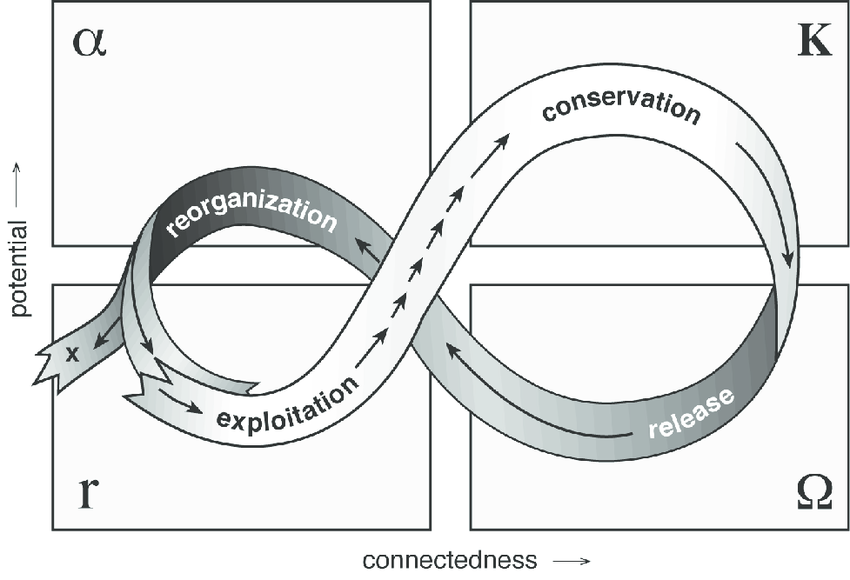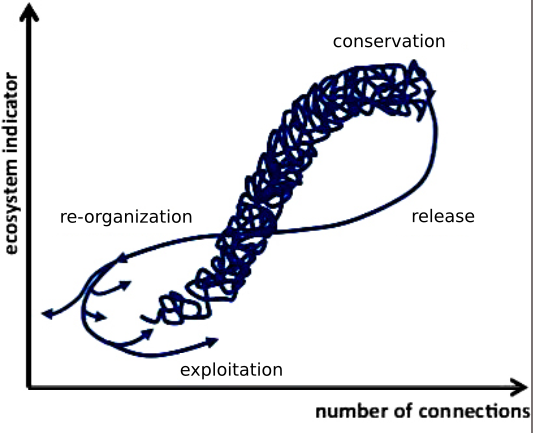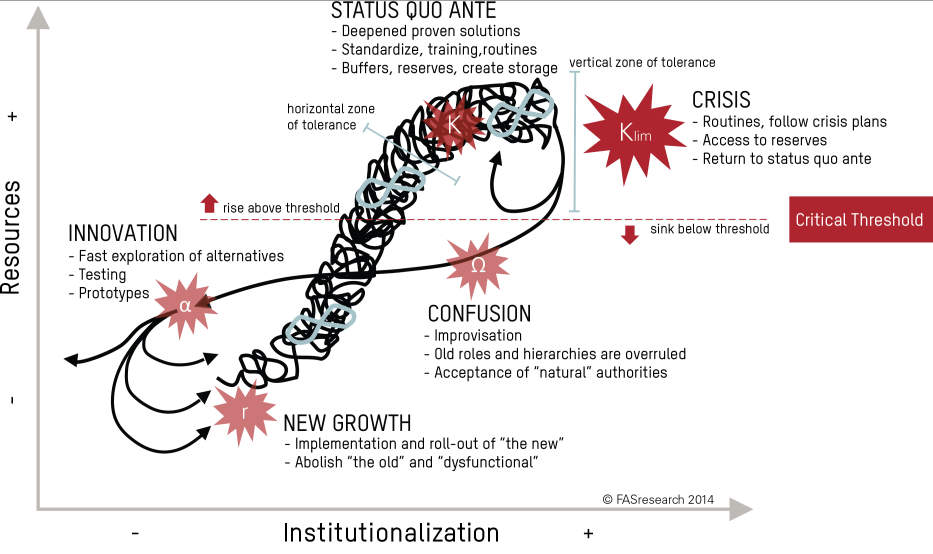


Image above: The Adaptive Cycle from Panarchy, edited by Lance H. Gunderson and C.S. Holling: Figure 2-1 (page 34). Copyright © 2002 Island Press
![]()
The model of the adaptive cycle was derived from the comparative study of the dynamics of ecosystems. It is meant to be a tool for thought. It focuses attention upon processes of destruction and reorganization, which are often neglected in favor of growth and conservation. Including these processes provides a more complete view of system dynamics that links together system organization, resilience, and dynamics.
Traditionally ecology has focused on the concept of succession that describes the transition from a time when exploitation (i.e., the rapid colonization of recently disturbed areas) is emphasized to a time when conservation (i.e., the slow accumulation and storage of energy and material) is emphasized.
Our current understanding of ecological dynamics however indicates that two additional functions - release and reorganization - are needed.
An adaptive cycle that alternates between long periods of aggregation and transformation of resources and shorter periods that create opportunities for innovation, is proposed as a fundamental unit for understanding complex systems from cells to ecosystems to societies.
For ecosystem and social-ecological system dynamics that can be represented by an adaptive cycle, four distinct phases have been identified:
The adaptive cycle exhibits two major phases (or transitions). The first, often referred to as the foreloop, from r to K, is the slow, incremental phase of growth and accumulation. The second, referred to as the backloop, from Omega to Alpha, is the rapid phase of reorganization leading to renewal.
During the slow sequence from exploitation to conservation, connectedness and stability increase and a capital of nutrients and biomass (in ecosystems) is slowly accumulated and sequestered. Competitive processes lead to a few species becoming dominant, with diversity retained in residual pockets preserved in a patchy landscape. While the accumulated capital is sequestered for the growing, maturing ecosystem, it also represents a gradual increase in the potential for other kinds of ecosystems and futures. For an economic or social system, the accumulating potential could as well be from the skills, networks of human relationships, and mutual trust that are incrementally developed and tested during the progression from r to K. Those also represent a potential developed and used in one setting, that could be available in transformed ones.
Adaptive cycles are nested in a hierarchy across time and space which helps explain how adaptive systems can, for brief moments, generate novel recombinations that are tested during longer periods of capital accumulation and storage. These windows of experimentation open briefly, but the results do not trigger cascading instabilities of the whole because of the stabilizing nature of nested hierarchies. In essence, larger and slower components of the hierarchy provide the memory of the past and of the distant to allow recovery of smaller and faster adaptive cycles. A nested hierarchy of adaptive cycles represents a panarchy.
![]()
Panarchy identifies four basic stages of ecosystems ...: exploitation, conservation, release and reorganization. All ecosystems, from the cellular to the global level, are said to go through these four stages of a dynamic adaptive cycle (see below).
...
The four stages of the adaptive cycle described above (analogous to birth, growth and maturation, death and renewal), have three properties that determine the dynamic characteristics of each cycle:
The adaptive cycle is the process that accounts for both the stability and change in complex systems. It periodically generates variability and novelty, either internally such as through genetic mutations or adaptation, or by accumulating resources that change the internal dynamics of an ecosystem. These changes are the triggers for experimentation. In the reorganization stage various experiments are tested and resources are reorganized in new configurations, some of which enter a new exploitation stage to repeat the cycle.
![]()
We can use resilience planning to identify and promote actions today that will lead to desired outcomes during transformative, “back loop,” periods.
![]()

![]() From Burkhard, B., B. D. Fath, and F. Müller. 2011
From Burkhard, B., B. D. Fath, and F. Müller. 2011
Burkhard et al (2011) felt the modified adaptive cycle (above) is more accurate for two reasons. First, rotating the figure 45° shows resources/potential (or ecosystem indicator) continuously dropping from release (Ω) until exploitation (α). Second, the overall trend of the growth and development stage (r → K) is increasing resources/potential and connectedness, but zooming into the small-scale level of this increase shows micro-deviations and micro-adaptive cycles make up this larger trend.
![]()

[The figure above represents the] Adaptive cycle applied to social systems. Stages in this cycle are similar to ecological stages, from new growth to status quo, to confusion, and innovation. The differentiation between crises that remain within the threshold and those that lead to dissolution are indicated by the vertical range of tolerance.
It is notable that there are many small-scale adaptive cycles embedded in the growth and development (r, K) stages, representing modular experimentation within the overall upward system trajectory.
α-stage Recognizing that a complex adaptive system can never return to the precise structure, function, and feedback as before (Folke 2006), Bellwood et al. (2004) wrote that resilience authors prefer the terms renewal, regeneration, and reorganization instead of the term recovery. We add to this concept the trajectory-based idea of reorientation such that the system escapes from the freefall of the collapse phase along a new trajectory for future development... The α-stage has the goal function of reorientation.
The idea of system identity comes into play at the α → r transition under the assumption that typical resilience thinking directs us to identify whether the period following the α-stage represents a new or the same regime, that is to say, whether it passed the critical threshold and operates under a new set of rules with different structure, function, and feedbacks.
r-stage The goal of the r-stage is growth; the trap of this stage is called the “poverty trap” (Gunderson and Holling 2002). A system in the r-stage has successfully reoriented post-crisis and now seeks the activation energy for rapid growth and development. In the study of the adaptive cycle, sufficient activation energy refers to the availability of resources and information to enter the growth stage. The system invests those resources during the growth stage to build structure with diverse nodes and flows. The poverty trap occurs when a system cannot access enough activation energy to reach a state where positive feedbacks drive growth internally. Additionally, with the goal of growth, the system at this stage must develop a configuration that is simple enough to scale, a characteristic that must be balanced with the cultivation of a level of internal complexity that will result in autocatalysis and self-sustainability... Here, innovation comes from plenty, rather than from constraint, as is the case in the K-stage. Once kickstarted along a growth trajectory, many resource flows are available for experimentation. In the r-stage, network connections are established, and trust and dependencies are built.
K-stage The K-stage, or equilibrium-stage, is about controlled development ... At this stage, negative feedback cycles dominate over positive feedbacks. When positive feedbacks exceed negative feedbacks to the extent of exhausting resources, the system trajectory can overshoot thresholds, sabotaging future system function. In addition to the possibility of overshoot, the trap here is the “rigidity trap” (Gunderson and Holling 2002). The rigidity trap occurs when a system becomes so refined in its processes that there is little room for further innovation...
Ω-stage The test of a system in the Ω-stage is its capacity to survive in the face of extreme disturbance or disordered collapse. A system must maintain vital functions throughout the crises. In human organizations, it is often up to leadership, both assigned and assumed, to identify and prioritize what that means. One of the ways that the diversity maintained through small-scale disturbances contributes to the resilience of the system is by cultivating a large stock of resources from which it can pull during a crisis, both in terms of organizations and their relationships, which is essential for leadership to emerge during the Ω-stage. ... Crisis coordinators that emerge during the Ω-stage are an example of “unpredictable combinations of [de novo entities] with existing components that can suddenly establish new domains of influence, opening an entirely new set of adaptive pathways." (Gunderson and Holling 2002:403).
![]() From Fath, Dean & Katzmair (2015)
From Fath, Dean & Katzmair (2015)
![]()

![]() Adapted from Understanding Innovation
Adapted from Understanding Innovation
Please Note: This site meshes with the long pre-existing Principia Cybernetica website (PCw). Parts of this site links to parts of PCw. Because PCw was created long ago and by other people, we used web annotations to add links from parts of PCw to this site and to add notes to PCw pages. To be able to see those links and notes, create a free Hypothes.is↗ account, log in and search for "user:CEStoicism".
